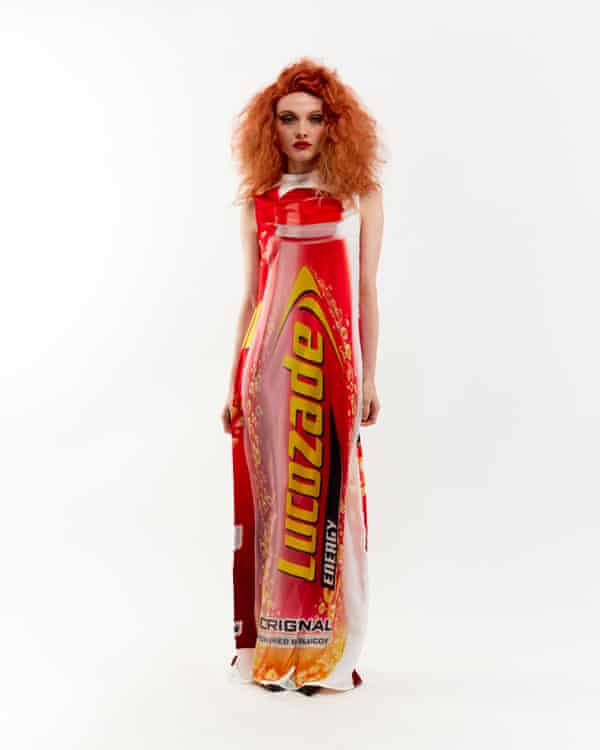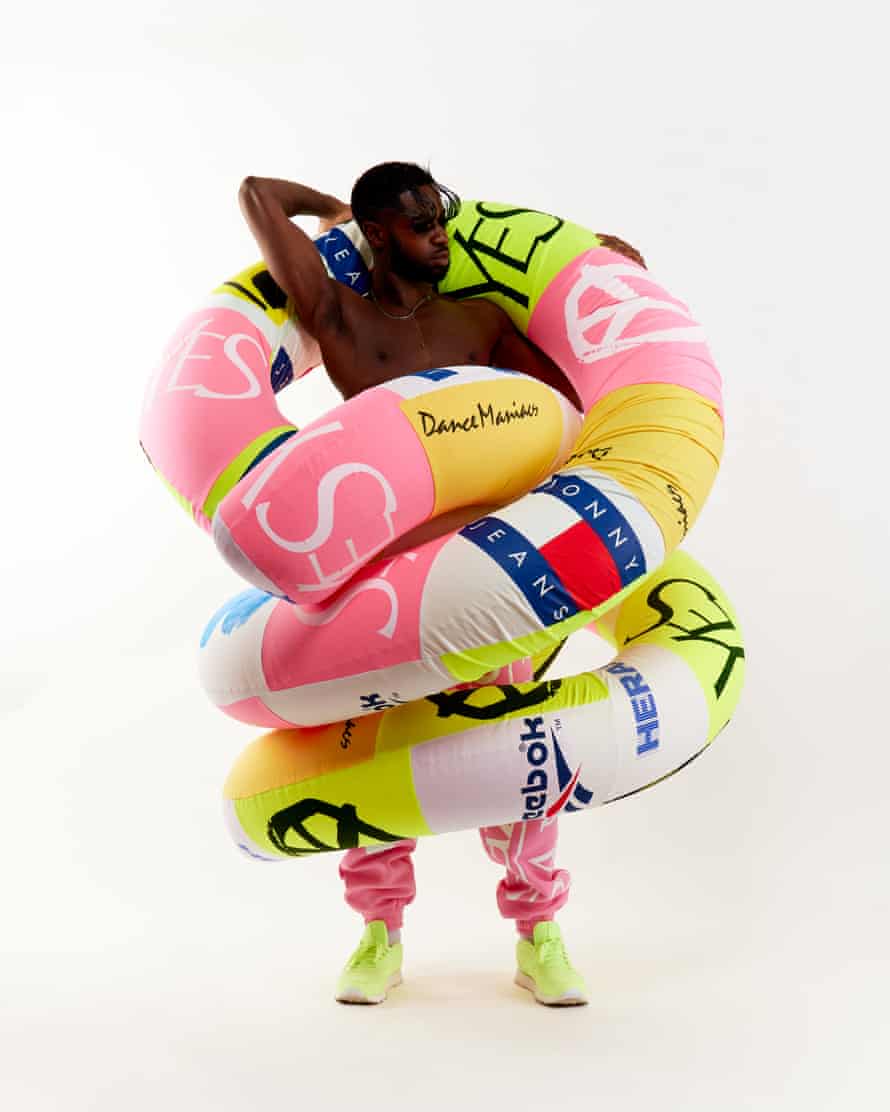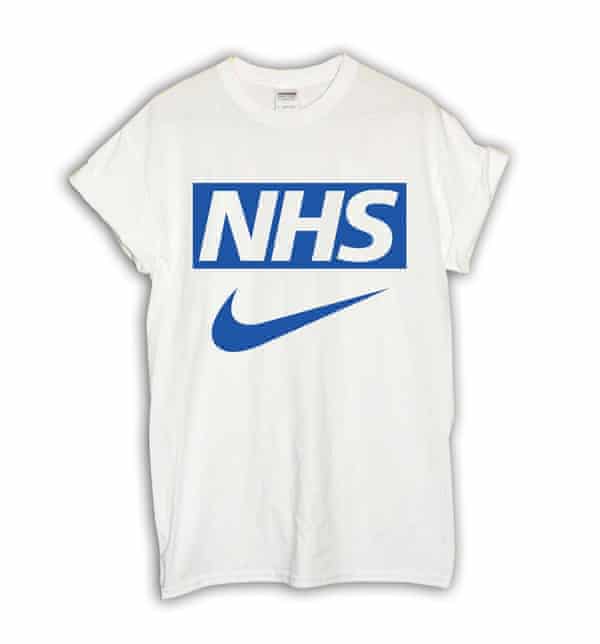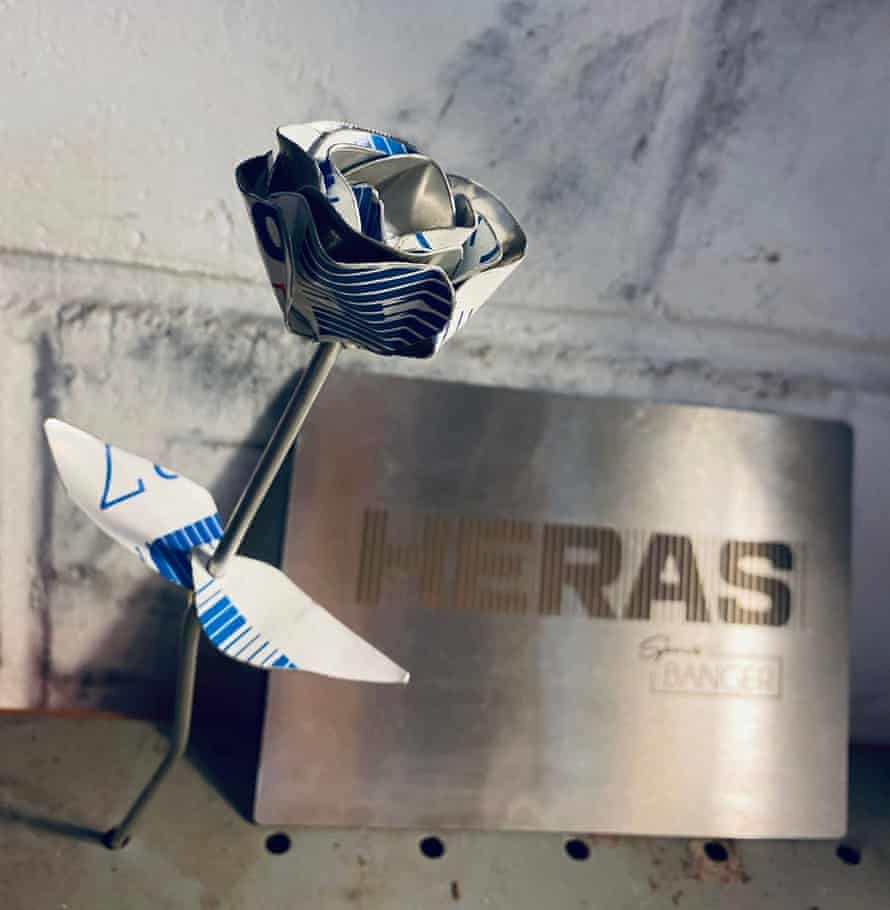‘Everything comes back to the spirit of rave’: Jonny Banger in conversation with Jarvis Cocker and Jeremy Deller | Fashion
Jonny Banger is something of a free spirit with his fingers in many pies. As well as his fashion label Sports Banger, which makes witty slogan T-shirts, sportswear and occasional catwalk fashion collections, he’s started the Heras record label, set up food banks, joined political protests, had a club residency and organised raves and club nights across the UK. He creates a scene around himself, so a variety of people gravitate to him. It’s like Warhol’s Factory but on London’s Seven Sisters Road, and with a better duty of care.
Maybe more surprisingly, and closer to home, he also reminds me of William Morris, the Victorian designer and philosopher. Morris was very ambitious for his art and what it could achieve. He believed in the sanctity and centrality of art to everything in his life, that beauty was something that everyone should have and wasn’t just for the rich. Morris was electrified by Marx and became a pioneer socialist, and I think that Jon has that spirit about him.
Quick Guide
Jarvis Cocker’s editor’s letter for his Collectors Edition of Observer New Review
Show

Welcome to the Collectors Edition.
We all collect things.
Often without noticing.
Open a drawer. Rummage in the pockets of your coat.
How did that get in there?
Other collections are more conscious: books, records, trainers, T-shirts, “likes”…
What’s that all about?
I have written a book called Good Pop, Bad Pop, which is based around the objects I found in the loft of a house I used to live in. Objects I collected over the course of a lifetime & then left to gather dust in the dark. Why? Am I a hoarder? Or did I think I was laying things away “for a rainy day”?
What does the collecting impulse say about us humans?
I decided to devote my guest-edit of the Observer’s New Review to investigating this question. Author Olivia Laing met me at the London Library & helped me collect my thoughts on this & a number of other subjects. There’s an article called “The collectors”, which explores different aspects of collecting through interviews with Peter Blake, artist Andy Holden, quilt-maker Loretta Pettway Bennett, digital archivist (& activist) Stephen Ellcock & others. Artist Jeremy Deller meets Jonny Banger, founder of Sports Banger: a rave/fashion/food bank/political activism collective whose latest clothing collection bears the label “The People Deserve Beauty”. Gallerist Sadie Coles sheds light on the motivations of art collectors in our Q&A. Plus there’s Lias Saoudi (of Fat White Family) sharing his cultural highlights in “On my radar”. A collection of domestic objects rendered in papier-mâche in “The grid”. And a birthday shout-out (in cartoon form) to the one & only David Attenborough.
I want to thank Jane Ferguson & her team at the Observer for giving me this opportunity & putting everything together so it all makes sense. Julian House designed Good Pop, Bad Pop & also brought his unique graphic sensibility to bear on this edition of the New Review. Mog Yoshihara & Kelly Kiley at Rough Trade Management set up my Zoom conversations with contributors. Jeannette Lee and Kim Sion had excellent suggestions. Raina Lampkins-Fielder introduced me to the work of the Gee’s Bend quilt-makers. Chrissy Blake hosted my interview with Peter Blake. Javi Aznarez drew a wonderful cartoon. Thank you all for your help.
Happy Sunday.
Love, Jarvis x
PS: there’s a playlist of music referred to in Good Pop, Bad Pop – you can get a sneak peek here.
In 2019, he invited me to his first fashion show, which was an incredible, chaotic mess that made perfect sense. From then on we kept in touch. In March 2020, the government sent out a form letter to every household explaining what was happening in terms of rules and help for people during the pandemic. Through Instagram and Twitter, Jon asked children across the country to draw on this letter to show how they were feeling. He received a deluge of responses and when I saw them on Instagram, I first thought: why didn’t I think of that? And, second: this would make a great exhibition. In October 2020, we opened The Covid Letters exhibition at London’s Foundling Museum.
I feel charmed by Jon as a person and his work is an absolute expression of him as a human being. Jarvis thought his multidisciplinary work would be a good story for the collectors issue, so we visited Jon’s north London studio, known as Maison de Bang Bang.
Jeremy Deller

Jarvis Cocker: I thought it would be nice to talk to you for this issue, because you make collections of clothes and you also collected the Covid letters. So could we talk and could you educate me? What are the origins of Sports Banger?
I grew up in Colchester. My mum was a psychiatric nurse and she got ill with leukaemia when I was 13 and died when I was 15. Then it was just me and my brother in the house. He was 18 and became my guardian.
I’d been bootlegging since I was 10 – my dad’s mate ran a sports shop and I’d make hooky T-shirts for myself on the heat press machine or we’d sell loads of sportswear from the warehouse at markets and car boot sales. He went down in the end because all his stock was fake.
From doing work experience at a record shop in Colchester I saw from the older kids how to build my escape route: college, get a student loan, go to uni. I did a music production HND at Sussex uni. I didn’t finish, but I put on my own parties in Brighton, started a record label and worked in pirate radio. That’s where the name Jonny Banger comes from.
I moved to London around 2008 and worked at a record distribution company as the warehouse kid, surrounded by all the records. Then I was at a venue in east London, where I booked their nights, but when I was 26 I quit. I was so depressed and skint that all I could do was eat noodles.
Around that time Tulisa from N-Dubz got nicked. Do you remember that? It was a Fake Sheikh/Sun on Sunday sting – she was arrested on suspicion of supplying class A drugs. So for my birthday I made myself a T-shirt printed with “Free Tulisa”. She was a working-class girl being dragged through the mud by the media. Everyone stopped me when I wore that T-shirt, took photos and talked to me. I could see there was something in it, and after that I started telling the story of my life through my T-shirts. That expanded to become the Sports Banger range. There’s been a lot of chaos, but that’s the thread that joins things together.
JC: It’s interesting you mention chaos. It’s something that comes up with a lot of the collectors, that a collection imposes order. Rather than getting engulfed by the chaos, you have a structure to hold on to.
Jeremy Deller: I think that’s what being an artist or a musician is: trying to make sense of things around you that you’re not happy about or that confuse you. You make art or music to deal with it, which is a very similar impulse.
When we do fashion shows I look through all the T-shirts and we take inspiration from them. The show pieces are just drawing the narrative in a different way. What’s good about Sports Banger is that it joins lots of different worlds and influences.

JD: How did you make the move from T-shirts to fashion collections?
T-shirts are the fun tokens that pay for everything we do. They come from the bottom, from the rave, and travel upwards. When I got my first studio on Seven Sisters Road, the previous tenants had just been shut down by SO15 counter-terrorist squad. I signed the contract flanked by portraits of Che Guevara and Tito. There was a brothel on the next floor, so it was quite awkward with people pressing the buzzer marked “BANGER”.
Next door was Tottenham Textiles, this co-working space for textile workers, and Luis who runs it opened my eyes to how clothes actually get made. Pattern-cutters, grading, overlocker machines. So from there we could use the T-shirts as cue points to inspire collections of clothes. Like, I made a “Team Nigella” T-shirt in response to the 2013 press campaign against Nigella Lawson during her court case, but I also collected every newspaper story throughout her ordeal, scanned and printed them on to fabric, and used that material to make a kimono-style parka for the 2020 collection.
JC: In your last collection you had a Lucozade dress and that really chimed with me. Lucozade used to be something you took to ill people in hospital and it wasn’t until I went to raves when I moved to London that I encountered people who drank it because they’d been up all night. Without them, Lucozade would have died as a product.
Yes – Lucozade sponsored my last show. The production costs were going up and up so I bootlegged a load of Energy T-shirts because I needed something to sell immediately after the show and I thought that would be a goer.
Two weeks before the show we’d spent so much that I got in touch with Lucozade and asked if they wanted to sponsor it. They came on board two days before showtime, which was wicked. Lucozade is a British institution – that bottle! There’s only a few bottles on the market that are iconic. The colour and the shape are so distinctive.

JD: Being at that fashion show reminded me of being in clubs. It’s emotional when you see something like that. It was also quite confrontational – especially the dancers wearing the Boris Johnson, Matt Hancock, Priti Patel, Rishi Sunak and Jacob Rees-Mogg Spitting Image masks. What was the collection called?
The original title was Honestly, We Can’t Afford It. We were going back and forth, wondering why we were doing this fashion show. Then I said: “Because the people need it!” So the title became The People Deserve Beauty. It did feel like we were taking a load of money and throwing it in the bin just for half an hour of joy. We don’t make the clothes we present at the shows to sell in shops. We just put it on a rail and go: “That looks nice. Maybe we’ll make it one day.”
We also gave out Heras roses at the show, which were crowdsourced. Our record label is called Heras because that’s the name of the fencing company who put up all the barriers at festivals. The fencing is used to prevent public access. Our records sound like what the fence looks like – hard, obnoxious, but a design classic built for purpose. I posted on Instagram asking for people to send in Heras logos because you can pop them off the fencing really easily. We got hundreds so we made roses and a showpiece corset. People sending them in didn’t know what we were doing with them, but they just wanted to help. There’s a beauty in that.
JD: Has the Heras fencing company ever been in touch about this?
No – people who work in their office have hit me up and said if I ever need stationery or USBs, to just ask. They’ve sent it over and I use it as record company merch.
I’ve had cease and desist letters from the government identity protection team over my NHS Nike T-shirt though. I originally made that in 2015 to support the junior doctors’ strike. That made me think about my mum’s work for the NHS and the care she received, and I wanted to do something. It brought up feelings about my past that I hadn’t really talked about.

The NHS is good, so I added the Nike tick to the logo. NHS = good. The sad thing is no one would have bought the T-shirt if it just said NHS. The NHS is free, but add the Nike swoosh and it’s worth £19.99.
I brought it back for the pandemic because of the kids’ meal voucher fiasco. It made me really angry. I’ve been that kid, picking up child benefit money, raised on income support and then disability benefits when my mum was too ill to work; my parents split up when I was four.
We sent up daily food deliveries to ICU staff at six local hospitals and also set up a food bank at a primary school using money from the T-shirt sales. Honestly, if you can throw a rave, you can throw a food bank.
All through this, I got emails from the government identity protection team, so in the end I had to make the T-shirt disappear. I got one email from Nike which was clearly from an automated image-tracking website so I contacted Nike direct to see if they meant it. I got a phone call from their head office the next day, saying I had an unofficial “licence to swoosh” and asking for my details so they could send a silent donation for the work I was doing.
JC: Tell me about the Covid letters…
They’re the best things we ever did. It came about because someone got in touch to say their NHS T-shirt arrived in the same post as their Boris letter. They said: “One of these is going in the bin.” I just thought we could do something better with that letter. I posted on Instagram: “If you received one of these and you’re under 16, draw on it and let us know how you feel.” It went from there. It was just an off-the-cuff action but I got so many replies. Every kid who sent a drawing in got a bootleg, pirate Blue Peter badge that I made and a certificate.
Parents told us that the act of defacing that letter let them have their first conversations with their children about government, welfare and the NHS. At the private view at the Foundling Museum, there was great energy, people laughing and talking to one another. It felt like the smoking area at a rave.

JC: That feeling is what makes things, especially activism, fun. You don’t want to walk around with a serious face, and it confuses people if you’ve having a laugh.
We got Caro Howell, director of the Foundling Museum, to write the name of our last fashion show on all the invitations, because she’s got beautiful handwriting. So she came here and wrote “The People Deserve Beauty” loads of times and told us about Hogarth’s The Analysis of Beauty and the line of beauty while she did it. I didn’t know any of those references.
JD: Rave in its widest sense infuses everything you do. Is that spirit of rave important to your work?
Yes it is. I host at raves. Hosting is different from rapping – I’m saying the same stuff that your mate’s saying in your ear, but I’m on stage with a microphone and a cigarette. I used to be a DJ when I was 16 and got to the semi-finals of the UK Battle for Supremacy. Everything I do comes back to the music and that spirit of rave. I think people feel a duty of care at a rave: if you see someone having a bad time you check if they’re all right. There weren’t raves during the pandemic, but the duty of care didn’t stop.
That’s what’s good about Sports Banger, it joins all these different worlds and influences. From ballroom dancers from Paris to drag queens, grime artists, indie kids, bricklayers and party ravers. You’ve got five-year-olds wearing our T-shirts and 85-year-olds. And everyone in between.
